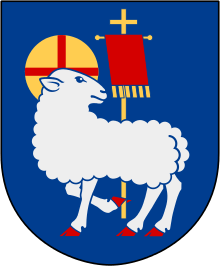Diocese of Västerås
| Diocese of Västerås Västerås stift | |
|---|---|
 Arms of the diocese of Västerås | |
| Location | |
| Country | Sweden |
| Deaneries | 9 kontrakt[1] |
| Coordinates | 59°36′45″N 16°32′28″E / 59.61250°N 16.54111°ECoordinates: 59°36′45″N 16°32′28″E / 59.61250°N 16.54111°E |
| Statistics | |
| Parishes | 59[1] |
| Congregations | 77[1] |
| Information | |
| Denomination | Church of Sweden |
| Established | 12th century[2] |
| Cathedral | Västerås Cathedral |
| Current leadership | |
| Bishop | Mikael Mogren[3] |
| Metropolitan Archbishop | Antje Jackelén |
| Map | |
 | |
| Website | |
| svenskakyrkan.se/vasterasstift | |
The Diocese of Västerås is a division of the Church of Sweden. Its home is in the Västerås Cathedral.
History
The diocese existed as a Catholic diocese from the eleventh to the sixteenth century. The see was founded at Munktorp, then removed about 1100 (not 1050) to Västerås by the English Cluniac missionary David, Abbot of Munktorp (David of Sweden), Bishop of Västerås, and one of the patron saints of Västerås Cathedral.
Before 1118 the Diocese of Sigtuna was divided into the Diocese of Uppsala and that of Västerås, and Henry, Bishop of Sigtuna (1134), was transferred to Västerås. Heathenism was not extinct by 1182. Charles (1257–1277) was a great benefactor, and Israel Erlandsson, O.S.B. (1260–1332; bishop, 1309–1332), mined copper in Dalecarlia and wrote "De Vita et Miraculis S. Erici" (Ser. rev. Svec., II, I, 272-276).
Otto (1501–1522) completed the cathedral. Peter Sunnanvader (1522–1523), formerly chancellor to Sten Sture, was executed for alleged treason in 1527. The last Catholic bishop, Petrus Magni (1524–1534), is supposed to have been consecrated on 1 May 1524, at Rome. In 1527 a Diet was held at Västerås which Protestantized the Swedish Church and separated it from Rome. Petrus Magni consecrated various bishops in 1528 and 1531 under protest. Though subjected latterly to humiliating tutelage by Gustavus Vasa, he retained the see until his death. The Dalecarlians rose repeatedly in defence of their religion, but were overcome by the cunning and violence of Gustavus I.
The cathedral of Västerås and the parish church of Mora were the only important churches in the diocese. At Westeraas there were a Franciscan convent (founded 1234) and a Hospital of the Holy Spirit (founded 1345). Munktorp Abbey was extinct before 1318. The Cistercian Abbey of Husby (Gudsberga, Mons Domini) in Dalecarlia, founded in 1477, and colonized from Aalvastra in 1486, lasted until 1544.
References
- 1 2 3 "Startsida" (in Swedish). Church of Sweden. Retrieved 26 August 2011.
- ↑ "Västerås stift". Nationalencyklopedin (in Swedish). Retrieved 26 August 2011. (subscription required)
- ↑ "Biskopen" (in Swedish). Church of Sweden. Retrieved 26 August 2011.
- Attribution
 This article incorporates text from a publication now in the public domain: Herbermann, Charles, ed. (1913). "Ancient See of Westeraas". Catholic Encyclopedia. New York: Robert Appleton. The entry cites:
This article incorporates text from a publication now in the public domain: Herbermann, Charles, ed. (1913). "Ancient See of Westeraas". Catholic Encyclopedia. New York: Robert Appleton. The entry cites:
- Historiskt-geographiskt och statistiskt Lexikon ofver Sverige, VII (Stockholm, 1866), 316-18;
- FANT, Scriptores rerum Svecicarum (Stockholm, 1818–1876);
- LILJERGREN, Diplomatarium Svecanum, I-III and Indices I-II by KARLESON (Stockholm, 1829);
- SILFVERSTOPLE, Svenskt Diplomatarium, 1401-1420 (Stockholm, 1875);
- KRONINGSSVARD AND LIDEN, Diplomatarium Dalekarlicum (Stockholm, 1842);
- Konung Gustaf den Forstes Registratur. ed. GRANLUND IV (Stockholm, 1868);
- Breviarium Arosiense (Basle, 1853);
- Acta Sanctorum, IV (Paris, 1868);
- JORGENSEN, Den nordiske Kirkes Grundloeggelse, II (Copenhagen, 1878), 856-857, suppl. 96, 97;
- RENTERDAHL, Swenska kyrkaus historia (Lund, 1838);
- Israel Erlandsson (Lund, 1850);
- MARTIN, Gustave Vasa et la Reforme en Suede; **SOHLBERG, Domkyrkan i Westeraas (Westeraas, 1834);
- HALL, Bidrag till; Kannedomen om Cistercienserorden i Sverige (Gefle, 1899).